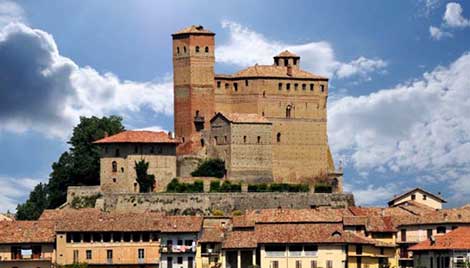
ALLA SCOPERTA DEI NOSTRI CASTELLI
Tra le ragioni per un viaggio nelle Langhe, vi può essere anche un tour dei suoi magnifici castelli e dei suggestivi paesaggi che li circondano.
Il Castello di Barolo
Di antiche origini – il primo corpo risale al X secolo – il castello ha subito nel corso del tempo diverse trasformazioni. Da maniero di difesa a residenza nobiliare di campagna, a rigido collegio di religiosi: ogni destinazione ha lasciato qualche traccia nelle sale del grande edificio.
Del castello colpisce soprattutto la mole, che sovrasta e quasi schiaccia il paese con la sua imponenza, immagine tangibile del potere dei signori dei luoghi.
All’interno si possono vedere le stanze con gli arredi d’epoca della marchesa Giulia Colbert, il salone degli stemmi, la biblioteca con il ricordo di Silvio Pellico, il patriota che, reduce dalle prigioni dello Spielberg, qui prestò la sua opera come segretario e bibliotecario per quasi vent’anni.
Ai piani superiori è ospitato il museo etnografico-enologico del Barolo, un’esposizione di antichi attrezzi viticoli ed enologici in uso nella zona, a documentazione della vita e del lavoro dei vignaioli nelle Langhe; in altre sale, una collezione di cristalli da vino e di vecchie fotografie del paese.
Nelle cantine, proprio dove la marchesa Giulia battezzò il primo Barolo, ha sede l’Enoteca Regionale.
Dal 2010 ospita il Museo del vino WiMu
Il Castello di Govone
Il castello barocco di Govone è probabilmente l’unico cui abbia messo mano l’architetto Juvarra.
Fu eretto nel 1778 su quello preesistente del 1300 ed è merito dei conti Solaro la trasformazione da fortezza nella fastosa dimora attuale.
I conti Solaro affidarono all’architetto Guarino Guarini i lavori di ampliamento e di abbellimento del castello. L’architetto preparò dei disegni ma non portò a termine il progetto. I lavori ripresero un secolo dopo da parte dell’architetto Benedetto Alfieri che li ultimò partendo proprio dai disegni del Guarini.
Nel 1730 vi soggiornò Jean-Jacques Rousseau, al tempo entrato al servizio del conte Ottavio Solaro.
Il Castello di Magliano Alfieri
Intorno al 1649, Catalano Alfieri diede ordine di iniziare i lavori per erigere l’attuale castello, a valle del bricco, sul quale sorgeva la precedente fortezza medievale edificata nel 996.
Pare che l’architetto fosse Amedeo di Castellamonte, lo stesso che nel 1658 diede la facciata a Palazzo Reale di Torino.
La pianta è quadrata, massiccia, con due torri cilindriche angolari. Il portone del palazzo in stile barocco mostra stipiti ed architravi in arenaria.
Le formelle a profondo intaglio sono anch’esse tipiche barocche. Qui compare anche lo stemma degli Alfieri, un’aquila nera, da sempre simbolo imperiale di potere.
Il Castello di Serralunga d’Alba
Lungo le strade del Barolo, svetta un castello che domina le colline: è il Castello di Serralunga d’Alba.
Costruito tra il 1340 ed il 1357, secondo forme poco usuali in Italia, ma tipiche dei Donjon francesi trecenteschi, fu una dei castelli della famiglia dei Falletti: mercanti e banchieri originari di Asti.
Nei secoli, I Falletti, rappresentarono la più importante dinastia di Langa, ottenendo la giurisdizione su oltre cinquanta feudi o comuni. La loro storia si intrecciò con quella del castello per oltre 600 anni.
Nel 1864, con la morte dell’ultima discendente, la filantropa Giulia Falletti Colbert, il maniero passò all’Opera Pia Barolo, per essere infine acquistato e restaurato dallo Stato nel 1949.
